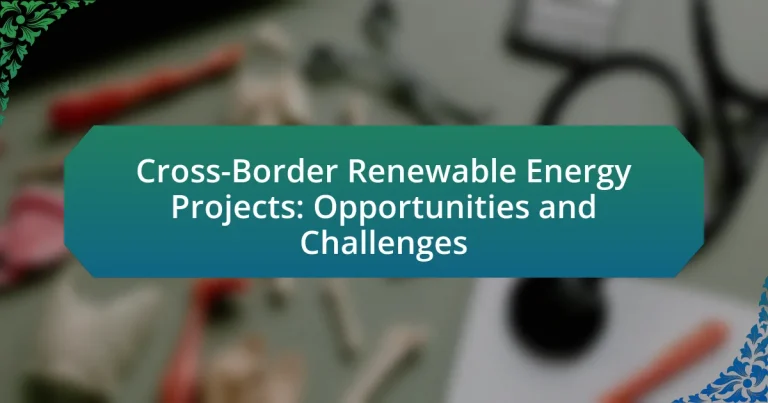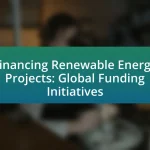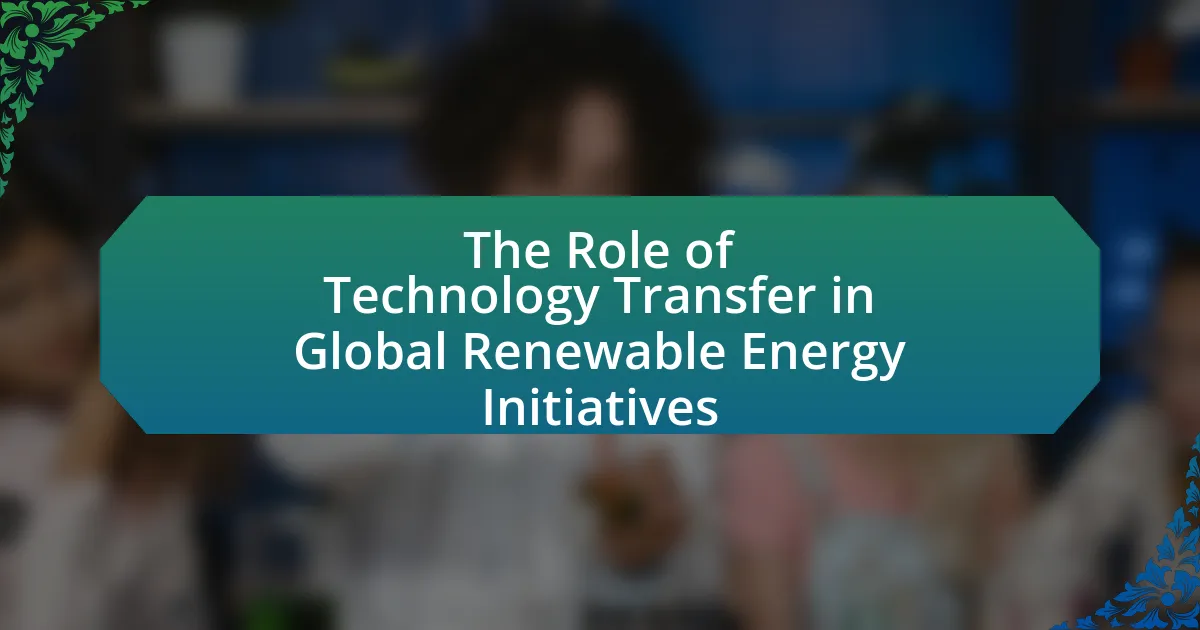Cross-Border Renewable Energy Projects involve the generation and transmission of renewable energy across national borders, facilitating resource sharing and enhancing energy security. The article outlines how these projects function, their key components, and the regulatory frameworks that influence their implementation. It discusses various types of projects, including electricity interconnections and joint renewable facilities, while highlighting the opportunities they present for economic growth and sustainability. Additionally, the article addresses the challenges faced, such as regulatory discrepancies, financial hurdles, and technical barriers, and emphasizes the importance of stakeholder engagement and international cooperation in overcoming these obstacles.

What are Cross-Border Renewable Energy Projects?
Cross-Border Renewable Energy Projects are initiatives that involve the generation and transmission of renewable energy across national borders. These projects facilitate the sharing of renewable resources, such as solar, wind, and hydroelectric power, between countries, enhancing energy security and sustainability. For instance, the European Union has implemented cross-border electricity interconnections to optimize energy distribution and reduce carbon emissions, demonstrating the effectiveness of such collaborations in achieving climate goals.
How do Cross-Border Renewable Energy Projects function?
Cross-border renewable energy projects function by facilitating the transfer of renewable energy resources, such as wind or solar power, across national borders to meet energy demands in different regions. These projects typically involve collaboration between countries to develop infrastructure, such as transmission lines and interconnections, that enable the efficient exchange of electricity generated from renewable sources. For instance, the North Sea Wind Power Hub aims to connect multiple countries through a shared offshore wind farm network, enhancing energy security and reducing carbon emissions. Such initiatives are supported by international agreements and regulatory frameworks that promote investment and cooperation in renewable energy development.
What are the key components of Cross-Border Renewable Energy Projects?
The key components of Cross-Border Renewable Energy Projects include regulatory frameworks, financing mechanisms, technology transfer, and grid interconnections. Regulatory frameworks establish the legal and policy environment necessary for collaboration between countries, ensuring compliance with international standards. Financing mechanisms are crucial for securing investment, often involving public-private partnerships and international funding sources. Technology transfer facilitates the sharing of renewable energy technologies and expertise across borders, enhancing project efficiency and sustainability. Grid interconnections enable the physical transmission of energy between countries, allowing for optimized resource utilization and energy security. These components collectively contribute to the successful implementation and operation of cross-border renewable energy initiatives.
How do regulatory frameworks influence Cross-Border Renewable Energy Projects?
Regulatory frameworks significantly influence Cross-Border Renewable Energy Projects by establishing the legal and operational parameters within which these projects must operate. These frameworks dictate the rules for energy trade, investment protections, and environmental standards, which can either facilitate or hinder project development. For instance, the European Union’s Renewable Energy Directive encourages cross-border cooperation and investment in renewable energy, promoting a unified market that enhances project viability. Conversely, inconsistent regulations between countries can create barriers, such as tariffs or differing environmental regulations, which complicate project execution and increase costs. Therefore, the alignment or divergence of regulatory frameworks directly impacts the feasibility and attractiveness of cross-border renewable energy initiatives.
What are the main types of Cross-Border Renewable Energy Projects?
The main types of Cross-Border Renewable Energy Projects include interconnections for electricity transmission, joint renewable energy generation facilities, and cross-border energy trading agreements. Interconnections allow for the transfer of electricity between countries, enhancing grid reliability and efficiency. Joint renewable energy generation facilities, such as wind or solar farms, are developed collaboratively by neighboring countries to optimize resource use and share costs. Cross-border energy trading agreements facilitate the exchange of renewable energy credits and power, promoting market integration and sustainability. These project types are essential for achieving energy security and reducing carbon emissions across borders.
What distinguishes solar energy projects from wind energy projects in a cross-border context?
Solar energy projects are distinguished from wind energy projects in a cross-border context primarily by their site-specific resource availability and infrastructure requirements. Solar projects depend on sunlight, which can vary significantly based on geographic location, while wind projects rely on wind patterns that may be more consistent across larger areas. For instance, regions with high solar irradiance, such as southern Europe, may be more suitable for solar installations, whereas areas with strong and consistent winds, like coastal regions, are ideal for wind farms. Additionally, solar energy projects often require less complex transmission infrastructure compared to wind projects, which may need extensive grid connections to transport electricity from remote wind farms to urban centers. This difference in infrastructure needs can affect the feasibility and cost-effectiveness of cross-border energy exchanges, as evidenced by the varying levels of investment and regulatory frameworks in different countries.
How do hydroelectric projects operate across borders?
Hydroelectric projects operate across borders through international agreements and cooperative frameworks that facilitate the sharing of water resources and energy generation. These projects often involve multiple countries collaborating on the construction and management of dams and power plants, ensuring that water flow and energy distribution are optimized for all parties involved. For instance, the Nile Basin Initiative, which includes multiple countries sharing the Nile River, exemplifies how nations can work together to manage hydroelectric resources while addressing environmental and economic concerns. Such cross-border projects require careful negotiation of water rights, environmental regulations, and energy trade agreements to ensure equitable benefits and minimize conflicts.
What opportunities do Cross-Border Renewable Energy Projects present?
Cross-border renewable energy projects present opportunities for enhanced energy security, economic growth, and environmental sustainability. These projects enable countries to share resources, such as wind and solar energy, which can lead to reduced energy costs and increased efficiency. For instance, the European Union’s internal energy market allows member states to trade electricity, resulting in a more resilient grid and lower prices for consumers. Additionally, such collaborations can attract investments and create jobs in the renewable energy sector, as seen in the interconnections between countries like Germany and Denmark, which have significantly increased renewable energy capacity.
How can these projects enhance energy security for participating countries?
Cross-border renewable energy projects enhance energy security for participating countries by diversifying energy sources and reducing dependence on single suppliers. These projects enable countries to share resources, such as wind and solar energy, which can stabilize supply during peak demand or outages. For instance, the European Union’s internal electricity market allows member states to trade electricity, thereby increasing resilience against energy shortages. Additionally, collaborative investments in infrastructure, like interconnectors, facilitate access to renewable energy, promoting grid stability and reliability. This interconnectedness not only mitigates risks associated with geopolitical tensions but also fosters a more sustainable energy landscape.
What economic benefits can arise from Cross-Border Renewable Energy Projects?
Cross-border renewable energy projects can generate significant economic benefits, including job creation, increased energy security, and cost savings. These projects often lead to the development of new infrastructure, which creates employment opportunities in construction, operation, and maintenance. For instance, the International Renewable Energy Agency reported that the renewable energy sector employed over 11 million people globally in 2018, with cross-border initiatives contributing to this growth.
Additionally, these projects enhance energy security by diversifying energy sources and reducing dependence on fossil fuels, which can stabilize energy prices. A study by the World Bank indicated that regional energy cooperation can lower electricity costs by up to 30% through shared resources and economies of scale. Furthermore, cross-border renewable energy projects can attract foreign investment, stimulating local economies and fostering technological innovation. Overall, the economic benefits of such projects are substantial and multifaceted, positively impacting both local and regional economies.

What challenges do Cross-Border Renewable Energy Projects face?
Cross-border renewable energy projects face regulatory, financial, and technical challenges. Regulatory challenges include differing national policies and standards that complicate project approval and implementation. Financial challenges arise from the need for significant investment and the uncertainty of returns due to fluctuating energy markets and currency risks. Technical challenges involve the integration of diverse energy systems and infrastructure across borders, which can lead to inefficiencies and increased costs. These challenges are evidenced by various projects that have encountered delays and budget overruns due to such complexities.
What are the political and regulatory challenges in Cross-Border Renewable Energy Projects?
Political and regulatory challenges in cross-border renewable energy projects include differing national policies, regulatory frameworks, and energy market structures. These discrepancies can lead to complications in project financing, permitting, and operational compliance. For instance, countries may have varying standards for environmental assessments, grid interconnections, and tariffs, which can hinder collaboration and increase costs. Additionally, geopolitical tensions can affect energy trade agreements and investment security, as seen in regions where energy resources are a point of contention. The lack of harmonized regulations across borders often results in delays and uncertainties, making it difficult for stakeholders to navigate the complexities of international energy projects.
How do differing national policies impact project implementation?
Differing national policies significantly impact project implementation by creating varying regulatory environments that can either facilitate or hinder cross-border renewable energy projects. For instance, countries with supportive policies, such as tax incentives and streamlined permitting processes, enable faster project development and attract investment. Conversely, nations with stringent regulations or inconsistent policy frameworks can lead to delays, increased costs, and uncertainty for project developers. A study by the International Renewable Energy Agency (IRENA) highlights that inconsistent policies across borders can result in a 20-30% increase in project costs due to compliance challenges and the need for additional legal consultations. Thus, the alignment or divergence of national policies directly influences the feasibility and success of renewable energy initiatives across borders.
What role do international agreements play in mitigating challenges?
International agreements play a crucial role in mitigating challenges associated with cross-border renewable energy projects by establishing frameworks for cooperation, regulatory alignment, and resource sharing among nations. These agreements facilitate the harmonization of policies, which is essential for addressing issues such as energy security, environmental protection, and investment stability. For instance, the Paris Agreement encourages countries to collaborate on climate action, thereby promoting renewable energy initiatives that transcend national borders. Additionally, agreements like the Energy Charter Treaty provide legal protections for investments in energy infrastructure, reducing risks for investors and fostering a conducive environment for project development.
What technical challenges are associated with Cross-Border Renewable Energy Projects?
Cross-border renewable energy projects face several technical challenges, including grid integration, regulatory discrepancies, and infrastructure limitations. Grid integration issues arise from the need to synchronize different national grids, which may operate on varying standards and technologies, complicating energy transfer. Regulatory discrepancies can hinder project development, as differing policies and standards across borders create compliance challenges. Infrastructure limitations, such as inadequate transmission lines or interconnection facilities, can restrict the capacity to transport renewable energy efficiently between countries. These challenges are critical to address for the successful implementation of cross-border renewable energy initiatives.
How do grid interconnections affect project feasibility?
Grid interconnections significantly enhance project feasibility by facilitating the efficient transfer of electricity across regions, which can lead to increased market access and reduced costs. When projects are interconnected with existing grids, they can tap into a larger customer base, thereby improving revenue potential. Additionally, interconnections allow for better integration of renewable energy sources, which can stabilize supply and reduce reliance on fossil fuels. For instance, the European Union’s internal electricity market has demonstrated that interconnected grids can lower electricity prices by up to 10% and enhance energy security. Thus, the presence of grid interconnections is a critical factor in determining the economic viability and operational success of cross-border renewable energy projects.
What are the technological barriers to successful implementation?
Technological barriers to successful implementation of cross-border renewable energy projects include inadequate grid infrastructure, interoperability issues, and limited energy storage solutions. Inadequate grid infrastructure often results in insufficient capacity to handle increased energy flows between countries, leading to inefficiencies and potential outages. Interoperability issues arise from differing standards and technologies used in various countries, complicating the integration of renewable energy sources. Limited energy storage solutions hinder the ability to balance supply and demand, particularly with intermittent renewable sources like solar and wind. These barriers have been documented in studies such as the International Renewable Energy Agency’s report on renewable energy integration, which highlights the need for enhanced technological frameworks to facilitate cross-border energy exchanges.
What social and environmental challenges must be considered?
Social and environmental challenges in cross-border renewable energy projects include community displacement, biodiversity loss, and cultural impacts. Community displacement occurs when land is repurposed for energy infrastructure, affecting local populations and their livelihoods. Biodiversity loss can result from habitat destruction during construction and operation, threatening local ecosystems. Cultural impacts arise when projects disrupt traditional practices and values of indigenous or local communities. For instance, the construction of large-scale solar farms has been linked to significant land-use changes that can displace communities and wildlife, as seen in various projects across the globe.
How do local communities influence Cross-Border Renewable Energy Projects?
Local communities significantly influence cross-border renewable energy projects through their engagement in decision-making processes and their ability to shape public perception. Their involvement often determines project acceptance or opposition, impacting regulatory approvals and funding opportunities. For instance, studies show that projects with strong local support are more likely to succeed; a 2019 report by the International Renewable Energy Agency indicated that community engagement can enhance project viability by up to 30%. Additionally, local communities can provide essential insights into environmental and social impacts, ensuring that projects align with regional needs and values. This influence is further evidenced by cases where community-led initiatives have successfully negotiated terms that benefit both the project developers and local stakeholders, demonstrating the critical role of local input in shaping sustainable energy solutions.
What environmental impacts must be assessed during project planning?
During project planning for cross-border renewable energy projects, the environmental impacts that must be assessed include biodiversity loss, habitat alteration, water resource impacts, air quality changes, and greenhouse gas emissions. Biodiversity loss can occur due to land use changes and habitat fragmentation, which can threaten local species. Habitat alteration may result from the construction and operation of energy facilities, affecting ecosystems. Water resource impacts involve potential changes to water quality and availability, particularly in areas where water bodies are affected by project activities. Air quality changes can arise from emissions during construction and operation phases, while greenhouse gas emissions must be evaluated to ensure compliance with climate goals. These assessments are critical for understanding the full environmental implications of renewable energy projects and ensuring sustainable development.

How can stakeholders effectively navigate Cross-Border Renewable Energy Projects?
Stakeholders can effectively navigate Cross-Border Renewable Energy Projects by establishing clear communication channels and understanding regulatory frameworks across different jurisdictions. Effective communication fosters collaboration among stakeholders, including governments, investors, and local communities, which is essential for addressing diverse interests and concerns. Understanding regulatory frameworks is crucial, as it allows stakeholders to comply with legal requirements and identify incentives or barriers specific to each country involved. For instance, the International Renewable Energy Agency (IRENA) highlights that harmonizing regulations can significantly reduce project costs and enhance investment attractiveness. By prioritizing these strategies, stakeholders can mitigate risks and enhance the success of cross-border renewable energy initiatives.
What best practices should be followed in Cross-Border Renewable Energy Projects?
Best practices in cross-border renewable energy projects include establishing clear regulatory frameworks, fostering stakeholder engagement, and ensuring financial viability. Clear regulatory frameworks facilitate compliance with diverse national laws, as seen in the European Union’s Renewable Energy Directive, which harmonizes regulations across member states. Stakeholder engagement, involving local communities and governments, enhances project acceptance and reduces opposition, evidenced by successful projects in Scandinavia that prioritized local input. Financial viability is crucial; projects should secure diverse funding sources and conduct thorough risk assessments to mitigate financial uncertainties, as demonstrated by the success of the Desertec initiative in North Africa, which attracted significant investment by addressing economic risks upfront.
How can stakeholder engagement improve project outcomes?
Stakeholder engagement can significantly improve project outcomes by fostering collaboration, enhancing communication, and ensuring that diverse perspectives are considered. Engaging stakeholders allows project teams to identify potential risks and opportunities early in the process, leading to more informed decision-making. For instance, a study by the International Renewable Energy Agency (IRENA) found that projects with active stakeholder involvement are 30% more likely to meet their objectives on time and within budget. This engagement also builds trust and support among stakeholders, which is crucial for the successful implementation of cross-border renewable energy projects, where regulatory and cultural differences can pose challenges.
What strategies can be employed to address regulatory hurdles?
To address regulatory hurdles in cross-border renewable energy projects, stakeholders can employ strategies such as engaging in proactive dialogue with regulatory authorities, conducting thorough regulatory impact assessments, and forming strategic partnerships with local entities. Proactive dialogue allows stakeholders to understand regulatory expectations and foster collaboration, which can lead to smoother project approvals. Regulatory impact assessments help identify potential challenges early, enabling stakeholders to develop mitigation strategies. Forming partnerships with local entities can enhance compliance with regional regulations and build community support, which is crucial for project success. These strategies have been effective in various projects, demonstrating their validity in overcoming regulatory challenges.
What lessons can be learned from existing Cross-Border Renewable Energy Projects?
Existing Cross-Border Renewable Energy Projects demonstrate the importance of regulatory alignment and stakeholder engagement for successful implementation. Projects like the North Sea Wind Power Hub highlight that harmonizing regulations across countries facilitates smoother project execution and reduces delays. Additionally, the interconnection of energy markets, as seen in the European Union’s internal electricity market, shows that collaborative frameworks can enhance energy security and optimize resource utilization. These examples underscore that effective communication and shared goals among participating nations are crucial for overcoming technical and political challenges in cross-border initiatives.
What successful case studies illustrate effective collaboration?
Successful case studies illustrating effective collaboration in cross-border renewable energy projects include the North Sea Wind Power Hub and the Desertec Initiative. The North Sea Wind Power Hub, a collaboration among several European countries, aims to create a large-scale offshore wind farm network, facilitating energy sharing and reducing costs. This project is backed by the European Commission, which supports its potential to provide up to 80 gigawatts of renewable energy by 2030. The Desertec Initiative, involving multiple stakeholders from Europe and North Africa, focuses on harnessing solar energy in the Sahara Desert to supply electricity to Europe, demonstrating the feasibility of large-scale renewable energy projects across borders. Both case studies exemplify how collaborative efforts can lead to significant advancements in renewable energy infrastructure and sustainability.
How can failures inform future project planning and execution?
Failures can inform future project planning and execution by providing critical insights into risk management, resource allocation, and stakeholder engagement. Analyzing past failures allows project managers to identify specific pitfalls, such as inadequate feasibility studies or insufficient stakeholder communication, which can lead to improved strategies in future projects. For instance, a study by the International Renewable Energy Agency (IRENA) highlights that learning from unsuccessful projects can enhance decision-making processes and lead to more resilient project frameworks. By systematically reviewing failures, organizations can adapt their methodologies, thereby increasing the likelihood of success in subsequent cross-border renewable energy initiatives.
What practical steps can stakeholders take to ensure project success?
Stakeholders can ensure project success by establishing clear communication channels and setting defined roles and responsibilities. Effective communication fosters collaboration and minimizes misunderstandings, which is crucial in cross-border renewable energy projects where diverse teams may be involved. Research indicates that projects with well-defined communication strategies are 30% more likely to meet their objectives on time and within budget. Additionally, stakeholders should conduct thorough risk assessments to identify potential challenges early, allowing for proactive mitigation strategies. Implementing regular progress reviews and adapting plans based on feedback further enhances project adaptability and success rates.




